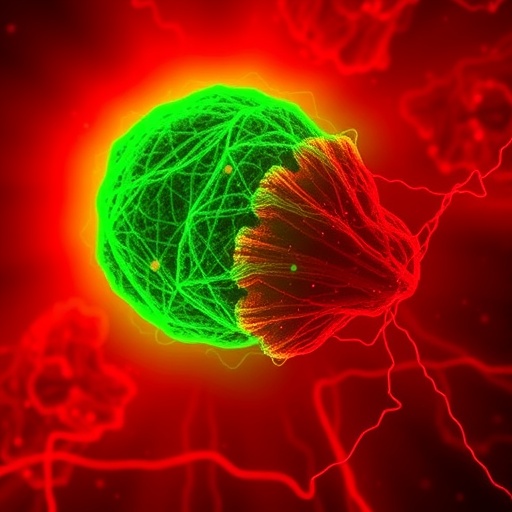In a groundbreaking study published in Cell Death Discovery, researchers have unveiled the pivotal role of the transcription factor FOXO3 in coordinating cell cycle arrest to regulate ferroptosis, a unique form of regulated cell death linked to iron-dependent lipid peroxidation. This discovery illuminates a novel axis within cellular stress response mechanisms, potentially unlocking new therapeutic strategies for conditions characterized by dysregulated ferroptosis, including neurodegenerative diseases, cancer, and ischemic injury.
FOXO3, a member of the forkhead box O (FOXO) family of transcription factors, is widely recognized for its capacity to modulate a range of essential cellular processes such as oxidative stress response, DNA repair, apoptosis, and longevity. The study conducted by Huang et al. delineates a precise molecular interplay wherein FOXO3 activation prompts a cell cycle arrest that is essential for the regulation of ferroptosis, marking a significant advance in our understanding of how cells integrate stress signals to determine their fate.
The authors employed a rigorous combination of molecular biology techniques, including gene expression profiling, chromatin immunoprecipitation, and live-cell imaging, to elucidate the dynamics of FOXO3 activation under ferroptotic stress. Their data demonstrated that FOXO3, upon induction, activates a transcriptional program leading to the upregulation of cell cycle inhibitors, effectively pausing the cell cycle at G1/S or G2/M checkpoints. This cell cycle arrest appears to be a protective mechanism that governs the cellular iron metabolism machinery, thereby modulating susceptibility to lipid peroxidation and subsequent ferroptotic cell death.
One of the most compelling findings of this research is the revelation that FOXO3-mediated cell cycle arrest serves as a critical checkpoint preventing premature ferroptosis in vulnerable cells. By stabilizing iron homeostasis and orchestrating the detoxification of lipid peroxides, FOXO3 indirectly curtails the oxidative damage characteristic of ferroptosis. This insight challenges previously held notions that ferroptosis is solely a pathway triggered by uncontrolled iron-dependent oxidative stress, positioning FOXO3 as an essential modulator rather than a passive participant.
Moreover, the study found that perturbations in the FOXO3 pathway, either through genetic knockdown or pharmacological inhibition, result in heightened ferroptotic sensitivity. Cells deficient in FOXO3 failed to adequately enact cell cycle arrest, leading to exacerbated lipid peroxidation and accelerated death. Conversely, enforced expression of FOXO3 rescued cells from ferroptosis, affirming its role as a master regulator in this death pathway.
The implications of these findings transcend fundamental cell biology, potentially influencing therapeutic strategies in oncology and neuroprotection. In cancer, where ferroptosis induction is an emerging strategy to eliminate resistant tumor cells, modulation of FOXO3 activity could fine-tune cell cycle checkpoints to enhance the efficacy of ferroptotic stimuli. Conversely, in neurodegenerative diseases where excessive ferroptosis contributes to neuronal loss, promoting FOXO3 activation might preserve cell viability and function.
Importantly, the molecular circuitry delineated by Huang and colleagues sheds light on the cross-talk between cell cycle dynamics and metabolic pathways governing ferroptosis. FOXO3’s transcriptional targets include a suite of genes involved in iron storage, lipid metabolism, and antioxidant defense, creating a multifaceted shield against ferroptotic triggers. This integrative regulatory network exemplifies how transcription factors synchronize distinct cellular programs to maintain homeostasis under stress.
The research further illustrates that FOXO3’s regulation of cell cycle arrest is context-specific, influenced by the nature and intensity of cellular stressors. Under mild oxidative challenges, transient FOXO3 activation induces temporary quiescence, enabling repair and survival. However, under severe iron overload or lipid peroxidation, prolonged FOXO3 activity may shift the balance towards controlled ferroptosis, suggesting a dual role dependent on cellular milieu.
By harnessing sophisticated genetic models and ferroptosis-specific assays, the study confirms that FOXO3’s interaction with cell cycle components such as p21 and p27 is indispensable for its anti-ferroptotic function. The coordinated upregulation of these cyclin-dependent kinase inhibitors enforces the cell cycle blockade, underscoring the intertwined nature of proliferation control and cell death decisions.
Another intriguing aspect revealed is FOXO3’s modulation of mitochondrial function, which plays a critical role in cellular redox status and susceptibility to ferroptosis. FOXO3 activation promotes mitochondrial biogenesis and augments antioxidant capacity, mitigating the mitochondrial reactive oxygen species (ROS) that catalyze lipid peroxidation. This mitochondrial crosstalk further consolidates the multifaceted defense orchestrated by FOXO3.
The translational potential of this study is immense. The authors highlight the prospects of small molecules or gene therapy vectors designed to activate FOXO3 selectively in pathological contexts characterized by ferroptotic dysregulation. Such interventions could offer precision control over cell fate, shifting the balance between survival and death with therapeutic benefit.
Beyond disease, these insights contribute fundamentally to the cell death landscape by integrating cell cycle regulation with ferroptotic mechanisms, previously considered largely independent. This synthesis enriches our conceptual framework of cellular stress responses, paving the way for novel research avenues exploring interplay between cell proliferation, metabolic control, and programmed cell death.
In summation, Huang et al.’s elucidation of FOXO3-mediated cell cycle arrest as a gatekeeper of ferroptosis reveals a sophisticated and nuanced regulatory axis central to cellular homeostasis. The intricately choreographed transcriptional responses orchestrated by FOXO3 highlight its indispensable role in determining cell fate in the face of ferroptotic stress, offering promising new directions for therapeutic innovation.
As ferroptosis continues to gain prominence in the realms of pathology and therapy, understanding its regulation by factors like FOXO3 reshapes how we approach complex diseases linked to oxidative stress and iron metabolism. This study marks a significant milestone toward harnessing programmed cell death pathways for precise clinical interventions, reflecting the extraordinary plasticity and resilience of cellular systems.
Subject of Research: Regulation of ferroptosis through FOXO3-induced cell cycle arrest
Article Title: Activation of a FOXO3-induced cell cycle arrest regulates ferroptosis
Article References:
Huang, H., van Sligtenhorst, M., Smits, A.M.M. et al. Activation of a FOXO3-induced cell cycle arrest regulates ferroptosis. Cell Death Discov. 11, 465 (2025). https://doi.org/10.1038/s41420-025-02760-x
Image Credits: AI Generated
DOI: https://doi.org/10.1038/s41420-025-02760-x
Tags: Cancer Treatment Strategiescell-cycle arrest mechanismscellular stress response pathwayschromatin immunoprecipitation methodsferroptosis regulationFOXO3 transcription factorgene expression profiling techniquesiron-dependent cell deathischemic injury researchlive-cell imaging studiesneurodegenerative disease therapiesoxidative stress response





